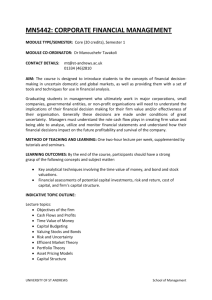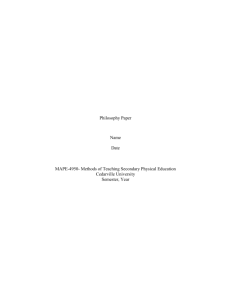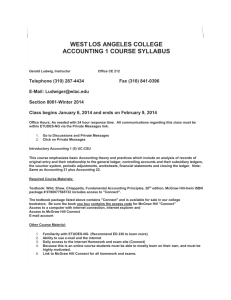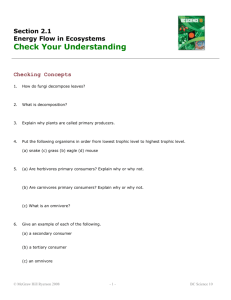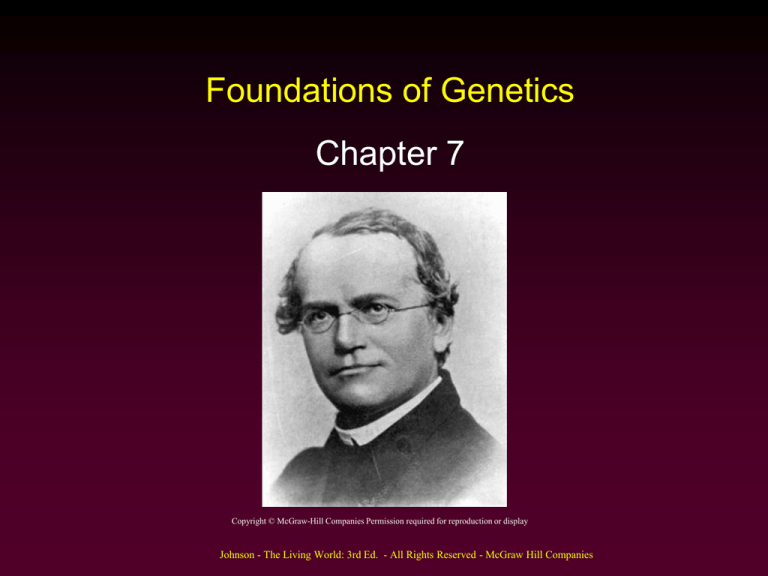
Foundations of Genetics
Chapter 7
Copyright © McGraw-Hill Companies Permission required for reproduction or display
Johnson - The Living World: 3rd Ed. - All Rights Reserved - McGraw Hill Companies
Outline
•
•
•
•
•
•
Gregor Mendel
Pea Experiments
Inheritance Theory
Punnett Squares
Epistasis
Multiple Alleles
Sex Linkage
Human Heredity
Mutations
Johnson - The Living World: 3rd Ed. - All Rights Reserved - McGraw Hill Companies
Gregor Mendel
•
Monk studied science and mathematics at
University of Vienna.
Worked with garden peas to study heredity.
- Many varieties available
- Infrequent version of a trait
- Small and easy to grow
- Left alone, flowers do not open
Johnson - The Living World: 3rd Ed. - All Rights Reserved - McGraw Hill Companies
Mendel’s Design
•
•
•
Let each variety self-fertilize for several
generations (True breeding).
P generation
Crossed two pea varieties exhibiting
alternative traits such as white versus purple
flowers.
Offspring resulted in F1 generation.
Allowed plants produced in crosses to self
fertilize and counted numbers of each type of
offspring.
F2 Generation
Johnson - The Living World: 3rd Ed. - All Rights Reserved - McGraw Hill Companies
Copyright © McGraw-Hill Companies Permission required for reproduction or display
Johnson - The Living World: 3rd Ed. - All Rights Reserved - McGraw Hill Companies
Mendel’s Results
•
•
F1 Generation
All F1 flowers were purple.
- Called expressed trait dominant and
unexpressed trait (white flowers)
recessive.
F2 Generation
Approximately 25% of individuals exhibited
white flowers.
Johnson - The Living World: 3rd Ed. - All Rights Reserved - McGraw Hill Companies
Mendel’s Results
•
F3 Generation
Ratio of purple:white flowers was 3:1.
- Concluded 3:1 ratio in F2 generation
was actually a 1:2:1 ratio.
- (1) True-breeding dominant: (2) not-true
breeding dominant: (1) true-breeding
recessive.
Johnson - The Living World: 3rd Ed. - All Rights Reserved - McGraw Hill Companies
Mendel’s Proposed Theory
•
•
Parents transmit information about traits to
offspring (genes).
Each parent contains two copies of the factor
governing each trait.
Homozygous - same copies
Heterozygous - different copies
Johnson - The Living World: 3rd Ed. - All Rights Reserved - McGraw Hill Companies
Mendel’s Proposed Theory
•
•
•
Alternative forms of a factor lead to
alternative traits (alleles).
Phenotype - Appearance (Physical
expression of genes).
Genotype - Alleles governing appearance.
Alleles inherited from each parent do not
affect each other.
Presence of allele does not ensure trait
expression.
Johnson - The Living World: 3rd Ed. - All Rights Reserved - McGraw Hill Companies
Punnett Squares
•
Punnett Squares can be used to visualize
crosses between two individuals.
Possible gametes of individual are listed
along horizontal side. And possible
gametes of the other individual are listed
along the vertical side.
- Genotypes of potential offspring are
represented by cells within square.
Frequency expressed as probability.
Johnson - The Living World: 3rd Ed. - All Rights Reserved - McGraw Hill Companies
Punnett Squares
Johnson - The Living World: 3rd Ed. - All Rights Reserved - McGraw Hill Companies
Testcross
•
Test unknown individual with a homozygous
recessive yields two alternatives:
Unknown individual homozygous (PP) PP
x pp: all offspring have purple flowers.
Unknown individual heterozygous (Pp) Pp
x pp: one-half offspring will have white
flowers (pp) and one-half have purple
flowers (Pp).
Johnson - The Living World: 3rd Ed. - All Rights Reserved - McGraw Hill Companies
Mendel’s Laws
•
•
First Law - Segregation
Only one allele specifying an alternative
trait can be carried in a particular gamete,
and gametes combine randomly in forming
offspring.
Second Law - Independent Assortment
Genes located on different chromosomes
are inherited independently of one another.
- Dihybrid Crosses
Johnson - The Living World: 3rd Ed. - All Rights Reserved - McGraw Hill Companies
Epistasis
•
Epistasis - Interaction between products of
two genes where one gene modifies the
other gene’s phenotypic expression.
Emerson - To produce pigment, a Zea
mays plant must possess at least one
functional copy of each enzyme gene.
Johnson - The Living World: 3rd Ed. - All Rights Reserved - McGraw Hill Companies
Epistasis
Johnson - The Living World: 3rd Ed. - All Rights Reserved - McGraw Hill Companies
Multiple Alleles
•
Often each allele has its own effect and the
alleles are considered codominant.
Human ABO Blood type
- Type A individuals only galactosamine
- Type B individuals add only galactose
- Type AB individuals add both sugars
- Type O individuals add neither sugar
Rh Blood Group
- Rh cell surface marker
Johnson - The Living World: 3rd Ed. - All Rights Reserved - McGraw Hill Companies
ABO Blood Groups
Copyright © McGraw-Hill Companies
Permission required for reproduction or display
Johnson - The Living World: 3rd Ed. - All Rights Reserved - McGraw Hill Companies
Genotypic Modifications
•
•
Pleiotrophic alleles have more than one
effect on the phenotype.
May have different effects on different
phenotypic consequences.
Characteristic of many inherited disorders.
Incomplete Dominance
Some alleles produce a heterozygote
phenotype that is intermediate between
those of the parents.
Johnson - The Living World: 3rd Ed. - All Rights Reserved - McGraw Hill Companies
Sex Linkage
•
A trait determined by a gene on the sex
chromosome is said to be sex-linked.
In Drosophila, sex is determined by the
number of copies of the x chromosome.
Johnson - The Living World: 3rd Ed. - All Rights Reserved - McGraw Hill Companies
Human Chromosomes
•
An individual’s particular array of
chromosomes is known as a karyotype.
Failure of chromosomes to separate
correctly during meiosis I or II is called
nondisjunction, which leads to aneuploidy
(abnormal number of chromosomes).
- Down Syndrome caused by trisomy 21.
Overall odds are 1 in 750.
Much higher in women over 45.
Johnson - The Living World: 3rd Ed. - All Rights Reserved - McGraw Hill Companies
Nondisjunction in Sex Chromosomes
•
•
X Chromosome
XXX or XXY yields Klinefelter Syndrome
XO yields Turner Syndrome
Y Chromosome
XYY - Antisocial ?
Johnson - The Living World: 3rd Ed. - All Rights Reserved - McGraw Hill Companies
Mutations in Human Heredity
•
Mutations are accidental changes in genes.
Rare, random, and usually result in
recessive alleles.
- Pedigrees used to study heredity.
Hemophilia - Inherited condition where
blood is slow to clot or does not clot at all.
Only expressed when individual has
no copies of the normal allele.
Royal Hempohilia - Sex-linked
Johnson - The Living World: 3rd Ed. - All Rights Reserved - McGraw Hill Companies
Sickle-Cell Anemia
•
Sickle-Cell Anemia is a recessive inherited
disorder in which afflicted individuals have
defective hemoglobin, and thus are unable to
properly transport oxygen to tissues.
- Heterozygotes usually appear normal.
- Homozygotes have Sickle-Cell, but are
resistant to malaria.
Copyright © McGraw-Hill Companies Permission required for reproduction or display
Johnson - The Living World: 3rd Ed. - All Rights Reserved - McGraw Hill Companies
Other Disorders
•
•
Tay-Sachs
Incurable heredity disorder which causes
brain to deteriorates.
- Nonfunctional form of hexosaminidas A
enzyme.
Huntington’s Disease
Inherited condition caused by dominant
allele causing progressive brain
deterioration.
- Symptoms usually develop late in life.
Johnson - The Living World: 3rd Ed. - All Rights Reserved - McGraw Hill Companies
Genetic Counseling and Therapy
•
Process of identifying parents at risk of
producing children with genetic defects and
assessing genetic state of early embryos.
Amniocentesis
Ultrasound
Chorionic Villi Sampling
Johnson - The Living World: 3rd Ed. - All Rights Reserved - McGraw Hill Companies
Review
•
•
•
•
•
•
Gregor Mendel
Pea Experiments
Inheritance Theory
Punnett Squares
Epistasis
Multiple Alleles
Sex Linkage
Human Heredity
Mutations
Johnson - The Living World: 3rd Ed. - All Rights Reserved - McGraw Hill Companies
Copyright © McGraw-Hill Companies Permission required for reproduction or display
Copyright © McGraw-Hill Companies Permission required for reproduction or display
Johnson - The Living World: 3rd Ed. - All Rights Reserved - McGraw Hill Companies




